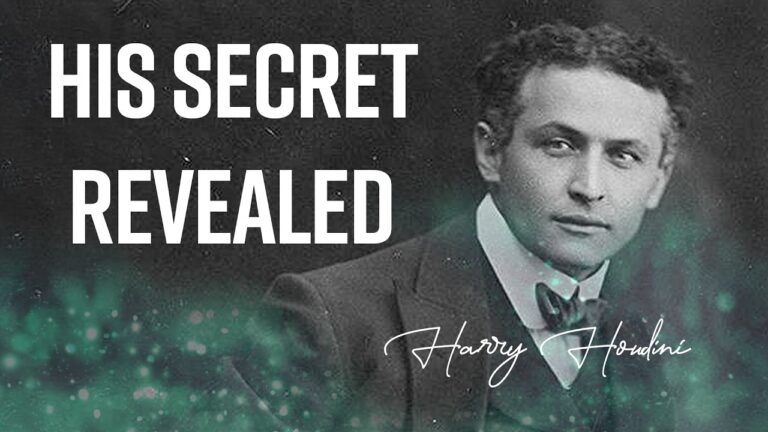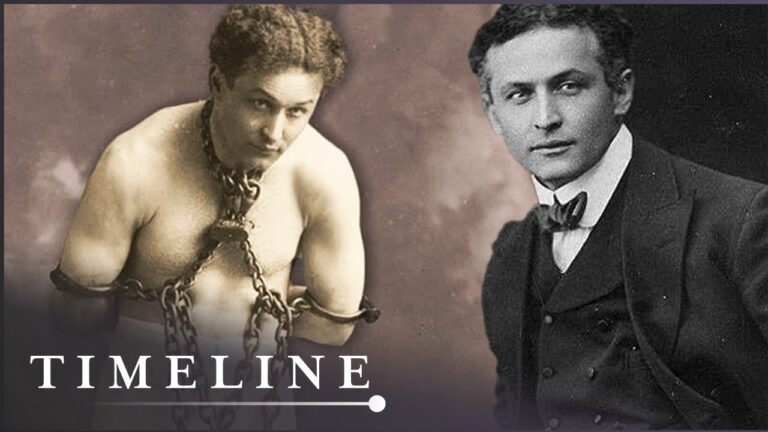Analyzing Houdini’s Most Dangerous Escapes: What Made Them So Captivating
Harry Houdini captivated audiences with death-defying stunts that pushed the limits of human endurance. His most famous escape act, the Chinese Water Torture Cell, required him to be suspended upside-down in a tank of water while wearing handcuffs and leg irons. His escapes were so compelling because they combined real physical danger with theatrical showmanship, creating genuine suspense as audiences wondered if they might witness a tragedy.
You might think Houdini’s tricks were mere illusions, but his dangerous water escapes required intense physical training and the ability to hold his breath for extended periods.
He would submerge himself for practice, pushing his body to its limits to perfect each performance.
The stakes were always real – during one performance of the Metamorphosis trunk escape, his wife Bess got stuck inside the trunk, proving these acts weren’t just for show. Houdini’s dedication to his craft often resulted in injuries, including a ruptured kidney from a particularly challenging escape.
Introduction

Harry Houdini captivated audiences with his death-defying escapes during the early 1900s. His performances pushed the limits of human endurance and challenged what people thought possible.
Your fascination with Houdini’s most dangerous stunts likely stems from the raw suspense they created. The Chinese Water Torture Cell stands as one of his most frightening acts, requiring him to escape while suspended upside-down in a tank of water.
Houdini’s outdoor performances added new levels of risk to his already dangerous repertoire.
He would train extensively underwater to prepare for these public spectacles, testing his physical limits each time.
The secrets behind these escapes lay in Houdini’s remarkable combination of physical strength, mental discipline, and technical skill. His handcuff escapes required intricate knowledge of lock mechanisms and extraordinary flexibility.
You’ll discover how each of these celebrated escapes tested not just Houdini’s abilities, but the audience’s nerve. His acts created a unique form of entertainment that merged genuine danger with theatrical showmanship.
The Psychological Elements of Houdini’s Escapes

Houdini’s mastery extended far beyond physical escapes – he skillfully manipulated human psychology to create unforgettable performances that kept audiences spellbound and questioning reality.
Building Suspense And Audience Engagement
Houdini knew the power of anticipation. He would inspect his restraints meticulously in front of spectators, drawing out each moment to build tension.
His dangerous water escapes became more dramatic as he visibly struggled underwater.
You could feel the energy shift in the room as he methodically prepared. He’d often invite audience members to examine the locks and chains, making them invested participants rather than passive observers.
His theatrical timing was precise – he’d emerge from escapes at the exact moment when audience anxiety peaked. This mastery of pacing transformed simple tricks into emotional experiences.
The Role Of Fear And Anticipation
The Chinese Water Torture Cell played directly into primal human fears. You’d watch him suspended upside down in a glass tank, fighting against drowning.
His escapes tapped into universal anxieties:
- Fear of drowning
- Claustrophobia
- Loss of control
- Death itself
Each performance balanced genuine danger with controlled showmanship. The real possibility of failure or injury created authentic emotional investment from audiences.
Psychological Manipulation And Perception
Houdini deliberately created false explanations for his methods, leading spectators to focus on impossible solutions while he executed the real technique elsewhere.
You’d find yourself watching his hands when the key move happened at his feet. He understood that perception could be directed and controlled.
His performances included calculated misdirection:
- Dramatic gestures drawing attention
- Strategic positioning of assistants
- Carefully timed movements during key moments
This mastery of attention control allowed him to perform seemingly impossible feats right before your eyes.
Technical Mastery And Preparation

Harry Houdini spent countless hours perfecting his skills through meticulous practice and scientific study. His deep commitment to mastering both the physical and technical aspects of his craft set him apart from other performers of his era.
Innovative Techniques And Tools
Houdini developed specialized lock-picking methods that revolutionized escape artistry. He concealed small metal tools in hidden pockets and even inside his mouth.
You can see his genius in how he adapted common items into escape tools. A short piece of flexible steel could serve multiple purposes – from manipulating lock mechanisms to creating leverage points.
His most brilliant innovation was the use of multiple backup methods for each escape. If one technique failed, he always had 2-3 alternative approaches ready.
Physical Conditioning And Training
Your body must be as prepared as your mind for dangerous escapes. Houdini maintained a strict daily training regimen that included:
- 2-3 hours of swimming to build lung capacity
- Flexibility exercises for contorting through tight spaces
- Strength training focused on grip and core muscles
- Practice holding his breath underwater for extended periods
He tested his limits regularly in controlled environments before attempting public stunts. This methodical approach helped him survive even when things went wrong.
The Science Behind The Stunts
Each trick required precise calculations and an understanding of physics. Houdini studied:
- Lock mechanisms and structural weak points
- Human anatomy and joint flexibility limits
- Water pressure effects at different depths
- Material strength under various conditions
His water escapes demonstrated this scientific approach perfectly. He calculated exact air requirements and factored in temperature, depth, and restraint positions.
He documented every detail of his experiments, creating detailed diagrams and notes to refine his techniques.
Theatrical Elements And Showmanship
Behind every death-defying escape, Houdini wove together carefully orchestrated dramatic elements to create unforgettable performances that kept audiences spellbound. His masterful blend of storytelling, stagecraft, and showmanship transformed simple tricks into theatrical spectacles.
Crafting A Narrative
Houdini never simply performed an escape – he created high-stakes drama. Before each performance, he built tension by describing the deadly risks and potential consequences of failure.
You can see this storytelling mastery in his famous Chinese Water Torture Cell escape, where he emphasized the genuine danger by having doctors verify the authenticity of his restraints.
His wife Bess played a crucial role, displaying visible concern that made audiences truly fear for his safety. This emotional investment turned simple stunts into edge-of-your-seat drama.
Stage Presence And Audience Interaction
Houdini commanded attention the moment he stepped onstage. His athletic physique and intense gaze projected both strength and vulnerability.
He invited audience members to inspect his restraints and equipment, making them active participants rather than passive observers. This involvement created a sense of authenticity and personal investment in the outcome.
His perfect timing kept spectators in suspense – he would emerge from dangerous escapes at precisely the moment when anxiety peaked. Every gesture and movement was calculated for maximum dramatic effect.
Use Of Costumes, Props, And Set Design
Houdini’s costume choices emphasized his physical capabilities. He often performed shirtless to display his muscular build and prove there were no hidden tools.
His technical crew meticulously prepared elaborate props and equipment. Each piece served both practical and theatrical purposes – handcuffs and chains weren’t just restraints but dramatic symbols of confinement.
The staging focused attention on key moments. Spotlights highlighted his struggles while darkness concealed method. Curtains revealed and concealed at precise moments to build suspense.
His props weren’t merely functional – they were imposing pieces of machinery that looked dangerous even before the performance began.
Notable Dangerous Escapes
Harry Houdini pushed the limits of human endurance and captivated audiences with death-defying acts that required incredible strength, skill, and mental fortitude. These escapes challenged him physically while keeping spectators on the edge of their seats.
The Water Torture Cell
The Chinese Water Torture Cell became one of Houdini’s signature acts. He would be suspended upside-down by his ankles and lowered into a glass tank filled with water.
Heavy stocks locked his feet in place while handcuffs restrained his hands. You can imagine the intense pressure as the cold water rushed over his face and body.
Houdini had to hold his breath for over 3 minutes while picking the locks and escaping. A curtain concealed the tank during his escape, adding to the suspense. An axe stood ready nearby in case of emergency.
The Milk Can Escape
In this feat, Houdini would be handcuffed and sealed inside a large milk can filled with water. The lid was secured with six padlocks while his assistants stirred the water to prove he wasn’t hiding in an air pocket.
You would watch in amazement as he emerged dripping wet but unharmed after several tense minutes. The confined space made this especially challenging – the can was barely larger than his body.
To heighten the drama, he would often invite audience members to hold their breath along with him during the escape.
The Buried Alive Stunt
This dangerous outdoor escape involved Houdini being handcuffed and placed in a pine box. Workers would then bury him under six feet of earth.
Your heart would race as you watched them pile dirt and sand on top. He had to dig upward through the soil after escaping the coffin – a feat requiring tremendous strength and composure.
During one attempt, the weight of the earth almost crushed the coffin before he could escape. He barely managed to signal for help and was pulled out nearly unconscious.
Calculated Risks And Safety Measures
Safety was critical to Harry Houdini’s success as an escape artist. His meticulous preparation and careful attention to detail helped him perform seemingly impossible feats while minimizing real danger.
Risk Assessment And Management
Houdini spent countless hours studying locks, handcuffs, and restraints to identify potential weak points and failure mechanisms. He tested every dangerous stunt thoroughly before performing it publicly.
You can see his methodical approach in the way he prepared for water escapes. He practiced holding his breath and staying calm underwater for increasing periods.
Each new venue required fresh safety checks. Houdini personally inspected all equipment and tested water temperatures, visibility conditions, and emergency access points.
Contingency Plans And Backup Strategies
Hidden lock picks and clever release mechanisms gave Houdini multiple escape options. His famous Chinese Water Torture Cell included emergency release valves and breakable glass.
A team of assistants stood ready with axes and tools if something went wrong. They knew exactly when to intervene based on precise timing cues.
Houdini maintained strict physical conditioning to handle unexpected complications. His strength and flexibility often meant the difference between success and disaster.
Collaboration With Assistants And Crew
Trusted assistants played vital roles in every major escape. They checked equipment, monitored time, and stood ready to help if needed.
Clear signals and code words let Houdini communicate secretly with his team. A specific hand gesture or word could trigger immediate assistance.
His wife Bess served as his most important partner, coordinating complex timing sequences and directing emergency responses when required.
The crew practiced rescue procedures regularly. Everyone knew their exact role and position during both normal performances and emergencies.
Impact On Magic History And Public Entertainment
Harry Houdini revolutionized entertainment by transforming magic from simple card tricks into dramatic spectacles of danger and escape. His influence spans multiple generations and continues to shape modern performance art.
Influence On Future Magicians And Performers
You can see Houdini’s direct impact on magic through the transformation of everyday objects into astonishing escape acts. His methods pushed performers to develop both physical and mental skills.
Modern escape artists still study his techniques. They learn how to break free from handcuffs, chains, and water tanks. His emphasis on showmanship taught magicians the importance of building suspense and connecting with audiences.
His incredible physical conditioning and stamina set new standards for performers. You’ll find his influence in the rigorous training regimens of contemporary magicians.
Media Coverage And Public Perception
Newspapers eagerly covered Houdini’s death-defying stunts, creating a new model for publicity in entertainment. His skilled use of media attention helped establish magic as a serious art form.
You could find his name in headlines across the world, as he challenged local police departments to restrain him. These public demonstrations turned skeptics into believers.
His role as president of the Society of American Magicians elevated the profession’s reputation. This leadership position helped establish professional standards in magic.
Lasting Legacy In Popular Culture
Your exposure to Houdini’s influence extends far beyond magic shows. His name has become synonymous with escape and achievement against impossible odds.
Movies, books, and TV shows continue to explore his life story. His techniques inspire modern entertainment, from action movies to reality shows featuring escape challenges.
His innovative underwater escapes remain a blueprint for dangerous performance art. You’ll find his influence in modern extreme sports and stunt performances.






